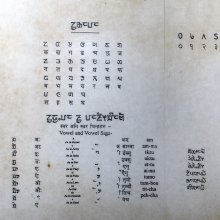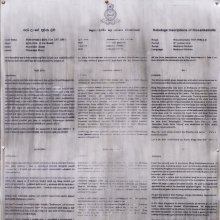Lipi, Lipī: 22 definitions
Introduction:
Lipi means something in Hinduism, Sanskrit, Buddhism, Pali, the history of ancient India, Marathi, Hindi, Tamil. If you want to know the exact meaning, history, etymology or English translation of this term then check out the descriptions on this page. Add your comment or reference to a book if you want to contribute to this summary article.
Images (photo gallery)
In Hinduism
Purana and Itihasa (epic history)
Source: archive.org: Puranic EncyclopediaLipi (लिपि).—(ALPHABET, SCRIPT). Origin. Lipi is the record in writing of the utterances by mouth. There are scientific and non-scientific statements about the origin of lipi. In the beginning people used figures of objects to express their ideas. They were called pictorial writings and are found even now in caves in Spain and France where the aborigines lived. Gradually the pictures vanished and letters took their place. (See full article at Story of Lipi from the Puranic encyclopaedia by Vettam Mani)
Source: archive.org: Shiva Purana - English TranslationLipi (लिपि) (Cf. Rekhā) refers to the “lines” (in the palm of one’s hand), according to the Śivapurāṇa 2.3.8.—Accordingly, Nārada said to Himavat:—“O lord of mountains, listen to my words with affability. They are true. They cannot be false. The lines in the palm [i.e., kara-rekhā] are the lines of Brahmā [i.e., brahma-lipi]. They cannot be untrue. O lord of mountains, there is no doubt that her husband will be such a person. You now hear what you have to do whereby you will be happy. There is a bridegroom like that. He is lord Śiva who has sportively assumed a physical form. In Him all bad characteristics are equal to good characteristics. [...]”.

The Purana (पुराण, purāṇas) refers to Sanskrit literature preserving ancient India’s vast cultural history, including historical legends, religious ceremonies, various arts and sciences. The eighteen mahapuranas total over 400,000 shlokas (metrical couplets) and date to at least several centuries BCE.
Ganitashastra (Mathematics and Algebra)
Source: archive.org: Hindu MathematicsLipi (लिपि) refers to the “alphabets” (reading and writing), which represented an important subject in the subject of Mathematics in Hindu Education.—The elementary stage in Hindu education lasted from the age of five till the age of twelve. This period slightly differed in the case of sons of kings and noblemen. The main subjects of study were lipi or lekhā (alphabets, reading and writing), rūpa (drawing and geometry) and gaṇanā (arithmetic). It is said in the Arthaśāstra of Kauṭilya (400 B.C.) that having undergone the ceremony of tonsure, the student shall learn the alphabets (lipi) and arithmetic (saṃkhyāna). We find in the Hathigumpha Inscription that king Kharavela (163 B.C.) of Kalinga spent nine years (from the age of sixteen to the age of 25) in learning lekhā, rūpa and gaṇanā. Prince Gautama began his education when he was eight years of age “firstly (with) writing and then arithmetic as the most important of the 72 sciences and arts”. Mention of lekhā, rūpa and gaṇanā is also found in the Jaina canonical works.

Ganitashastra (शिल्पशास्त्र, gaṇitaśāstra) refers to the ancient Indian science of mathematics, algebra, number theory, arithmetic, etc. Closely allied with astronomy, both were commonly taught and studied in universities, even since the 1st millennium BCE. Ganita-shastra also includes ritualistic math-books such as the Shulba-sutras.
Ayurveda (science of life)
Toxicology (Study and Treatment of poison)
Source: Shodhganga: Kasyapa Samhita—Text on Visha ChikitsaLipi (लिपि) refers to “syllables” (with the sound of Bindu), as described in the Kāśyapa Saṃhitā: an ancient Sanskrit text from the Pāñcarātra tradition dealing with both Tantra and Viṣacikitsā—an important topic from Āyurveda which deals with the study of Toxicology (Viṣavidyā or Sarpavidyā).—According to the Kaśyapasaṃhita verse V.63, “Adorned with atripañcaka and the syllables with the sound of Bindu (bindunāda-lipi-saṃyuta), the goddess extirpates the kālakūṭa poison just as the rising sun at dawn destroys darkness at dawn”.

Āyurveda (आयुर्वेद, ayurveda) is a branch of Indian science dealing with medicine, herbalism, taxology, anatomy, surgery, alchemy and related topics. Traditional practice of Āyurveda in ancient India dates back to at least the first millenium BC. Literature is commonly written in Sanskrit using various poetic metres.
India history and geography
Source: Cologne Digital Sanskrit Dictionaries: Indian Epigraphical GlossaryLipi.—(SII 3), a letter. Note: lipi is defined in the “Indian epigraphical glossary” as it can be found on ancient inscriptions commonly written in Sanskrit, Prakrit or Dravidian languages.

The history of India traces the identification of countries, villages, towns and other regions of India, as well as mythology, zoology, royal dynasties, rulers, tribes, local festivities and traditions and regional languages. Ancient India enjoyed religious freedom and encourages the path of Dharma, a concept common to Buddhism, Hinduism, and Jainism.
Languages of India and abroad
Pali-English dictionary
Source: BuddhaSasana: Concise Pali-English Dictionarylipi : (f.) a writing; a letter.
Source: Sutta: The Pali Text Society's Pali-English DictionaryLipi, (fr. lip; late Sk. lipi) the alphabet; a letter of the alphabet; writing Miln. 79. (Page 584)

Pali is the language of the Tipiṭaka, which is the sacred canon of Theravāda Buddhism and contains much of the Buddha’s speech. Closeley related to Sanskrit, both languages are used interchangeably between religions.
Marathi-English dictionary
Source: DDSA: The Molesworth Marathi and English Dictionarylipi (लिपि).—f (S) Writing in general, hand-writing, a character, a manner of writing. 2 Painting, drawing, delineating. 3 Smearing or plastering.
Source: DDSA: The Aryabhusan school dictionary, Marathi-Englishlipi (लिपि).—f Writing. Painting, delineating.
Marathi is an Indo-European language having over 70 million native speakers people in (predominantly) Maharashtra India. Marathi, like many other Indo-Aryan languages, evolved from early forms of Prakrit, which itself is a subset of Sanskrit, one of the most ancient languages of the world.
Sanskrit dictionary
Source: DDSA: The practical Sanskrit-English dictionaryLipi (लिपि) or Lipī (लिपी).—f. [lip ik vā ṅīp]
1) Anointing, smearing.
2) Writing, hand-writing.
3) The written characters, letters, alphabet; यवनाल्लिप्याम् (yavanāllipyām) Vārt.; लिपेर्यथावद्ग्रहणेन वाङ्मयं नदीमुखेनेव समुद्रमाविशत् (liperyathāvadgrahaṇena vāṅmayaṃ nadīmukheneva samudramāviśat) R.3.28;18.46.
4) The art of writing.
5) A writing (as a letter, document, manuscript &c.); अयं दरिद्रो भवितेति वैधसीं लिपिं ललाटेऽर्थिजनस्य जाग्रतीम् (ayaṃ daridro bhaviteti vaidhasīṃ lipiṃ lalāṭe'rthijanasya jāgratīm) N.1.15,138.
6) Painting, drawing.
7) Outward appearance.
Derivable forms: lipiḥ (लिपिः).
Source: Cologne Digital Sanskrit Dictionaries: Edgerton Buddhist Hybrid Sanskrit DictionaryLipi (लिपि).—f. (Sanskrit), writing; in Lalitavistara 125.19 ff. the Bodhi-sattva lists 64 kinds of script; in Mahāvastu i.135.5 ff. a similar but much shorter list; Senart's note compares the two. Non-Sanskrit items from either list are included here.
Source: Cologne Digital Sanskrit Dictionaries: Shabda-Sagara Sanskrit-English DictionaryLipi (लिपि).—f. (-piḥ-pī) 1. Writing in general, handwriting. 2. A writing, a written paper or book, &c. 3. Painting, drawing. 4. Smearing. 5. Alphabet. 6. A document. E. lip to spread, (ink, &c.) Unadi aff. ik with ṅīp optionally added, the radical vowel unchanged.
Source: Cologne Digital Sanskrit Dictionaries: Benfey Sanskrit-English DictionaryLipi (लिपि).—[lip + ī], f. 1. Anointing, smearing. 2. Painting. 3. Writing, [Daśakumāracarita] in
Lipi can also be spelled as Lipī (लिपी).
Source: Cologne Digital Sanskrit Dictionaries: Cappeller Sanskrit-English DictionaryLipi (लिपि).—[feminine] smearing, rubbing over, writing.
Source: Cologne Digital Sanskrit Dictionaries: Monier-Williams Sanskrit-English Dictionary1) Lipi (लिपि):—[from lip] f. ([according to] to [cf. Lexicographers, esp. such as amarasiṃha, halāyudha, hemacandra, etc.] also lipī) smearing, anointing etc. (See -kara)
2) [v.s. ...] painting, drawing, [cf. Lexicographers, esp. such as amarasiṃha, halāyudha, hemacandra, etc.]
3) [v.s. ...] writing, letters, alphabet, art or manner of writing, [Kāvya literature; Kathāsaritsāgara]
4) [v.s. ...] anything written, manuscript, inscription, letter, document, [Naiṣadha-carita; Lalita-vistara]
5) [v.s. ...] outward appearance (lipim-√āp, with [genitive case], ‘to assume the appearance of’; citrāṃ lipiṃ √nī, ‘to decorate beautifully’), [Vikramāṅkadeva-carita, by Bilhaṇa]
Source: Cologne Digital Sanskrit Dictionaries: Yates Sanskrit-English DictionaryLipi (लिपि):—[(piḥ-pī)] 2. 3. f. Writing in general; painting; smearing.
Source: DDSA: Paia-sadda-mahannavo; a comprehensive Prakrit Hindi dictionary (S)Lipi (लिपि) in the Sanskrit language is related to the Prakrit words: Livi, Livī.
[Sanskrit to German]
Sanskrit, also spelled संस्कृतम् (saṃskṛtam), is an ancient language of India commonly seen as the grandmother of the Indo-European language family (even English!). Closely allied with Prakrit and Pali, Sanskrit is more exhaustive in both grammar and terms and has the most extensive collection of literature in the world, greatly surpassing its sister-languages Greek and Latin.
Hindi dictionary
Source: DDSA: A practical Hindi-English dictionaryLipi (लिपि):—(nf) a script; writing; ~[kara/kāra] a scribe; clerk; copy; —[kāla] the date of copying/scribing; ~[grāma] grapheme; •[vijñāna] graphemics; ~[vaddha] recorded, written, reduced to black and white; hence ~[baddhatā; ~vijñāna] [śāstra] science of writing.
...
Kannada-English dictionary
Source: Alar: Kannada-English corpusLipi (ಲಿಪಿ):—
1) [noun] the act of smearing, daubing.
2) [noun] the act of writing (letters and symbols, with pen, pencil, etc.).
3) [noun] a character representing an alphabet of a language.
4) [noun] something written by hand; hand-writing.
5) [noun] the supposed destiny of a person written before his or her birth, by Brahma; fate.
6) [noun] (log.) a written document, passage, that serves as a proof in establishing the truth.
Kannada is a Dravidian language (as opposed to the Indo-European language family) mainly spoken in the southwestern region of India.
Tamil dictionary
Source: DDSA: University of Madras: Tamil LexiconLipi (லிபி) noun < lipi.
1. Letter of alphabet; எழுத்து. ஐம்பதோர் விதமான லிபிகளும் [ezhuthu. aimbathor vithamana lipigalum] (திருப்புகழ் [thiruppugazh] 322).
2. Destiny, fate; விதி. [vithi.] Colloq.
--- OR ---
Lipi (லிபி) [lipittal] 11 transitive verb & intransitive < lipi. To write; எழுதுதல். வம்பு லிபித்தானயன் [ezhuthuthal. vambu lipithanayan] (சங்கர. அந்தாதி. [sangara. anthathi.] 11.)
Tamil is an ancient language of India from the Dravidian family spoken by roughly 250 million people mainly in southern India and Sri Lanka.
See also (Relevant definitions)
Starts with (+19): Lipibaddh, Lipibaddha, Lipigallu, Lipigara, Lipijna, Lipijnana, Lipijne, Lipik, Lipika, Lipika-vishrama, Lipikara, Lipikarman, Lipikarmanirmita, Lipikartu, Lipikk-taansinu, Lipikka, Lipikka-tamsinu, Lipikrit-kula, Lipimatra, Lipinu.
Ends with (+124): Abulipi, Accalipi, Adhyaharinilipi, Agnilipi, Alamkaralipi, Alipi, Angalipi, Angaliyalipi, Anguliyalipi, Animittalipi, Ankalipi, Antarikshadevalipi, Anulipi, Anulomalipi, Anupadrutalipi, Asuralipi, Atamatalipi, Bhalalipi, Bhaumadevalipi, Bhavalipi.
Full-text (+141): Lipika, Lipijna, Lipisajja, Libi, Lipikara, Limpi, Livi, Sarvabhutarutagrahani, Shastravarta, Angalipi, Lipishala, Lipiphalaka, Lipijnana, Kaladhautalipi, Prakshepalipi, Vajralipi, Samkhyalipi, Mudralipi, Serau lipis, Daradalipi.
Relevant text
Search found 20 books and stories containing Lipi, Lipī; (plurals include: Lipis, Lipīs). You can also click to the full overview containing English textual excerpts. Below are direct links for the most relevant articles:
Puranic encyclopaedia (by Vettam Mani)
Cidgaganacandrika (study) (by S. Mahalakshmi)
Verse 31 [Place of Parāvāk] < [Chapter 2 - Second Vimarśa]
Verse 74 [Śakti Prabhāva] < [Chapter 2 - Second Vimarśa]
Verse 179 [Śakti as Śabdatattva in the form of Praṇava] < [Chapter 3 - Third Vimarśa]
Satirical works of Kshemendra (study) (by Arpana Devi)
5.18. The Teacher of the Child (dāraka-upādhyāya) < [Chapter 5 - Kṣemendra’s objectives of Satire]
3. Rasa or the sentiment < [Chapter 4 - Literary study of the Three Satirical Works]
Sahitya-kaumudi by Baladeva Vidyabhushana (by Gaurapada Dāsa)
Text 10.42 < [Chapter 10 - Ornaments of Meaning]
Text 9.37 [Citra-kāvya] < [Chapter 9 - Ornaments of Sound]
Lalitopakhyana (Lalita Mahatmya) (by G.V. Tagare)
Kautilya Arthashastra (by R. Shamasastry)
Chapter 5 - Association with the Aged < [Book 1 - Concerning Discipline]




